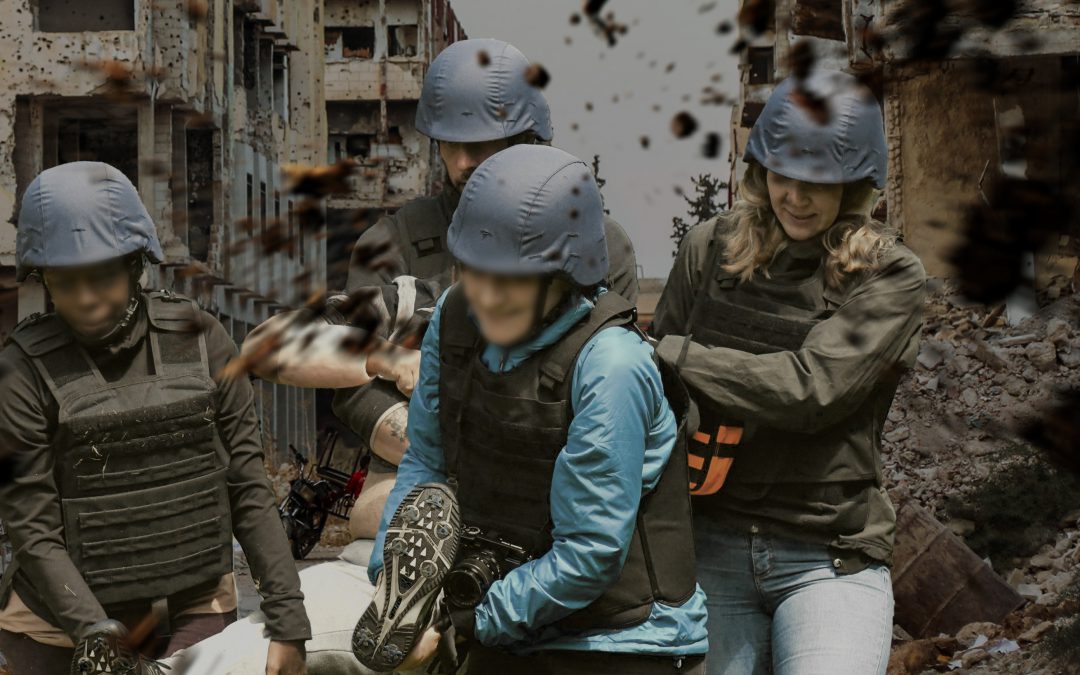ADRIÀ ROCHA CUTILLER — Ken, British ex-military, doesn’t like tripods. Better to avoid them when possible, he says, although many times it is not and he has to accept them. “Why don’t I like them? Because they are easy to confuse with heavy rifles. They are dangerous and can make the journalist a target”, he explains.
This summer, Ken Perry has been busy. He and his company, Cosain Consultancy, which works advising large media outlets, have been running several free security courses for journalists. “We are doing it because in Ukraine, while we were there on a mission, we saw that many freelance journalists were arriving without experience nor training. This is our way of returning the favour for their great work ”, explains Ken, friendly in the treatment but tough, as it should be, when it comes to getting down to business.
For anyone who goes to a conflict —or who find themselves in it— these types of courses, very common all around the world but very expensive, are key: their contents, at first, seem obvious, something that becomes evident as soon as it is explained. However, not everything is so easy: in risky situations, the normal becomes unimaginable, and an easy scenario to run in your mind becomes difficult to perform when it presents itself in the real world.
There are many examples: on the road, after an accident, any injured person must be prevented from making any sudden movement, especially at their back. The person may be injured even if there is no blood. And if a wound festers endlessly, even if doing so means the casualty loses an arm or leg, applying a tourniquet as soon as possible can save a life. Every minute that passes the chances of survival go down.
“In first aid there is a very clear protocol to follow. The order is very important: Is there any more danger in the area? Is the person responding? Are there injuries that could be fatal? Is the airway open? Is the person breathing normally? Is the skin colour white? Does the person respond now after the first steps? How are the pupils? Are there more wounds and blood on the body? This is some sort of a ladder that has to be followed down according to the answer to each question. Answering these questions wrongly or late can cost the injured person their life”, says Jarrod, a paramedic, also an ex-military man and a course teacher.
After theory, though, comes practice: “Look, now we will go to a mass grave embedded with a Ukrainian militia, and there we will interview the leader of this militia. Be prepared and get in the car,” explains Ken, who during practice turns into a Ukrainian reckless driver, “Sergei”.
Arriving with the militia, the mortar fire begins. The militiaman is wounded: it is time now the journalists must follow the ladder. In this case, at first sight, the militiaman has a seemingly catastrophic wound in the arm. The procedure is simple to explain but complicated to carry out: apply a tourniquet, grab the man and, with him in tow, run for hard cover towards the nearest building. In cases like this, the injured person’s neck and back don’t matter much. The choice here is clear: either three people die or three survive, even if one of them has a damaged spine for life.
“In cases like this it is important to listen to the artillery. It has a rhythm, and if you learn its pattern you can guess when it will drop; from the time it is fired until it hits there is a delay of a few minutes. Learning to listen to the rhythm of the artillery can save one’s life”, explains Ken, who says that in Ukraine, artillery works like a tennis match: first the Russians fire a series of artillery, then the Ukrainians answer. It is between this dialogue of rival mortars that the journalist —or anyone— can flee the area being bombed.
The most important thing of all, however, is to always plan before leaving: establish main and alternative routes, study risks, locate hospitals along the way, manage accreditations and action protocols before official and unofficial authorities —in Ukraine armed civilians, sometimes drunk, set up checkpoints on the road—, decide the use of certain phone applications and determine a schedule of communication with the newsroom and so on. This is critical, because although the plan will always end up breaking down, it is a stable base on which to work.
“There are many times that the plan collapses, and then instinct is king,” says Ken. “A few months ago a member of our team was driving with some journalists on a road near the front line in Ukraine, and his gut told him something was wrong. He told the driver to find an alternative road. 30 minutes later the Russians attacked where they had been. His instinct saved them. You have to trust it.”


Recent Comments